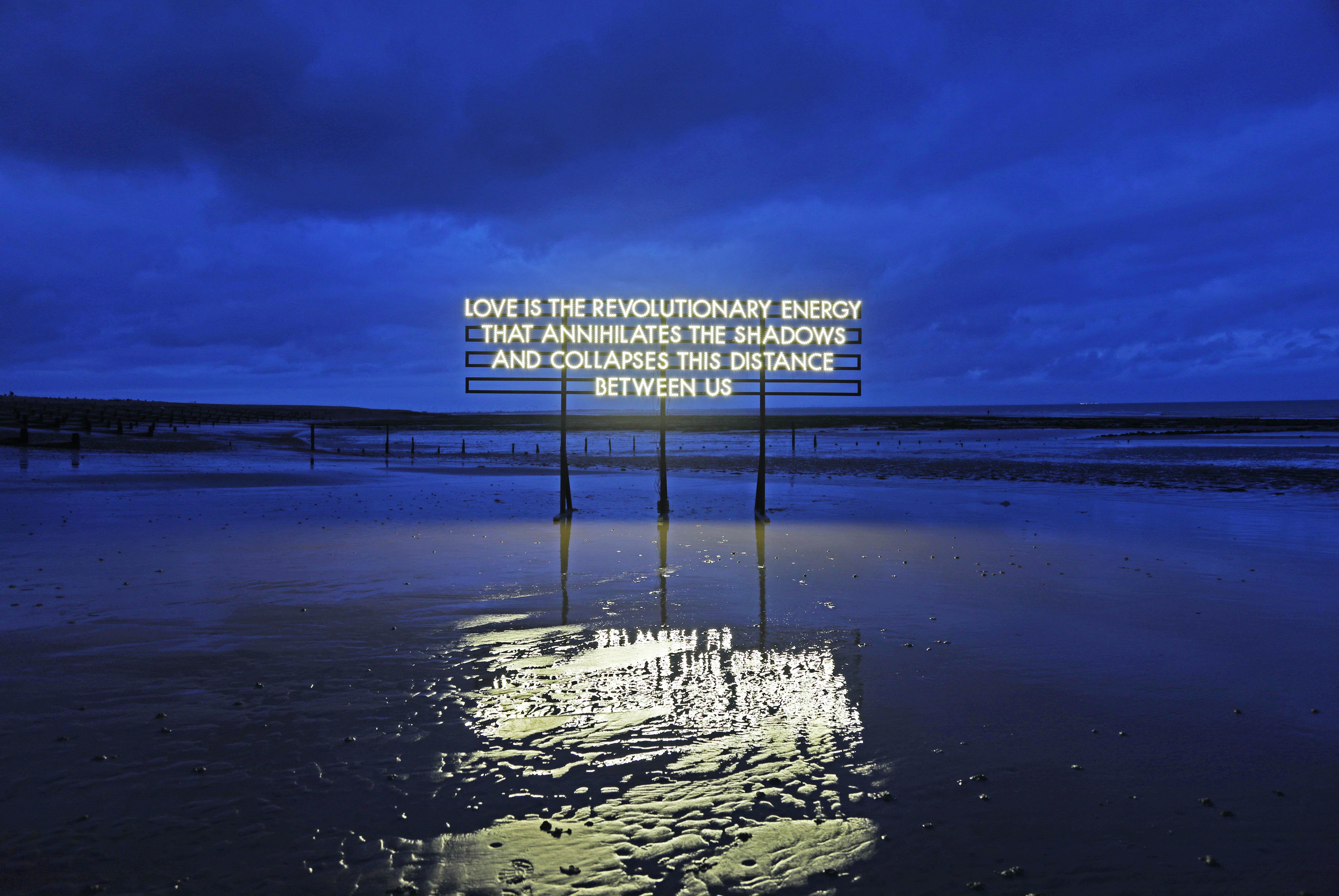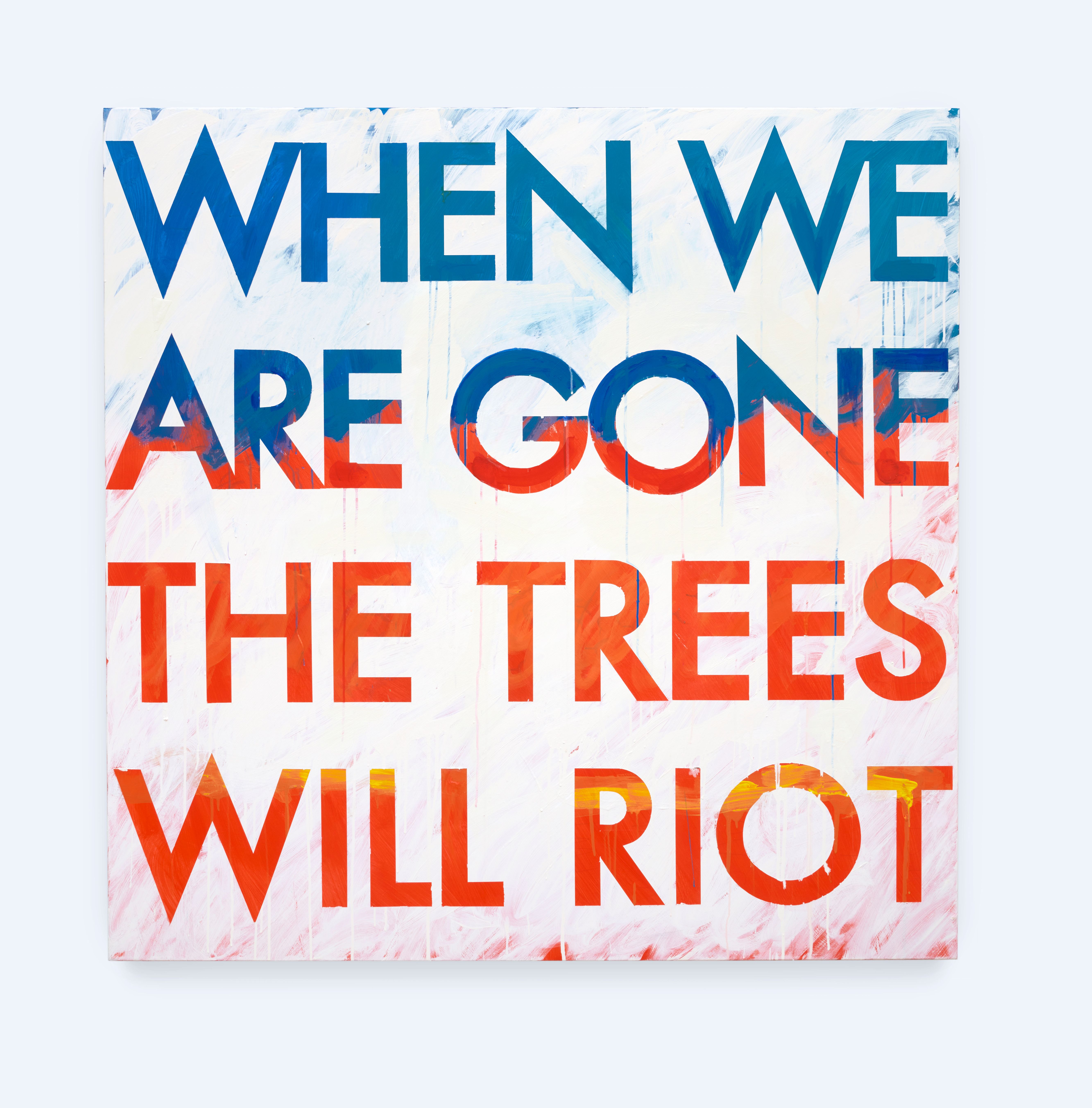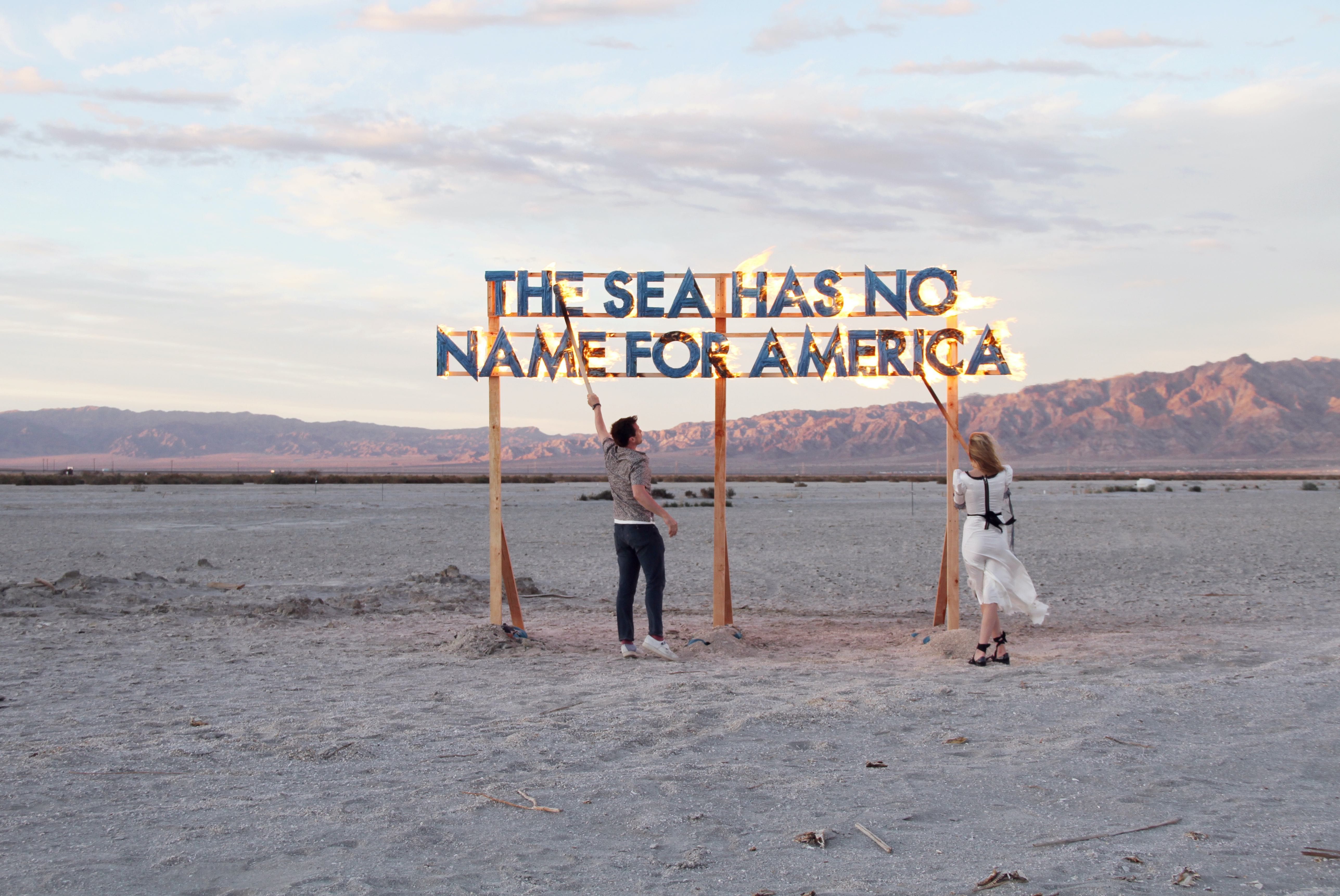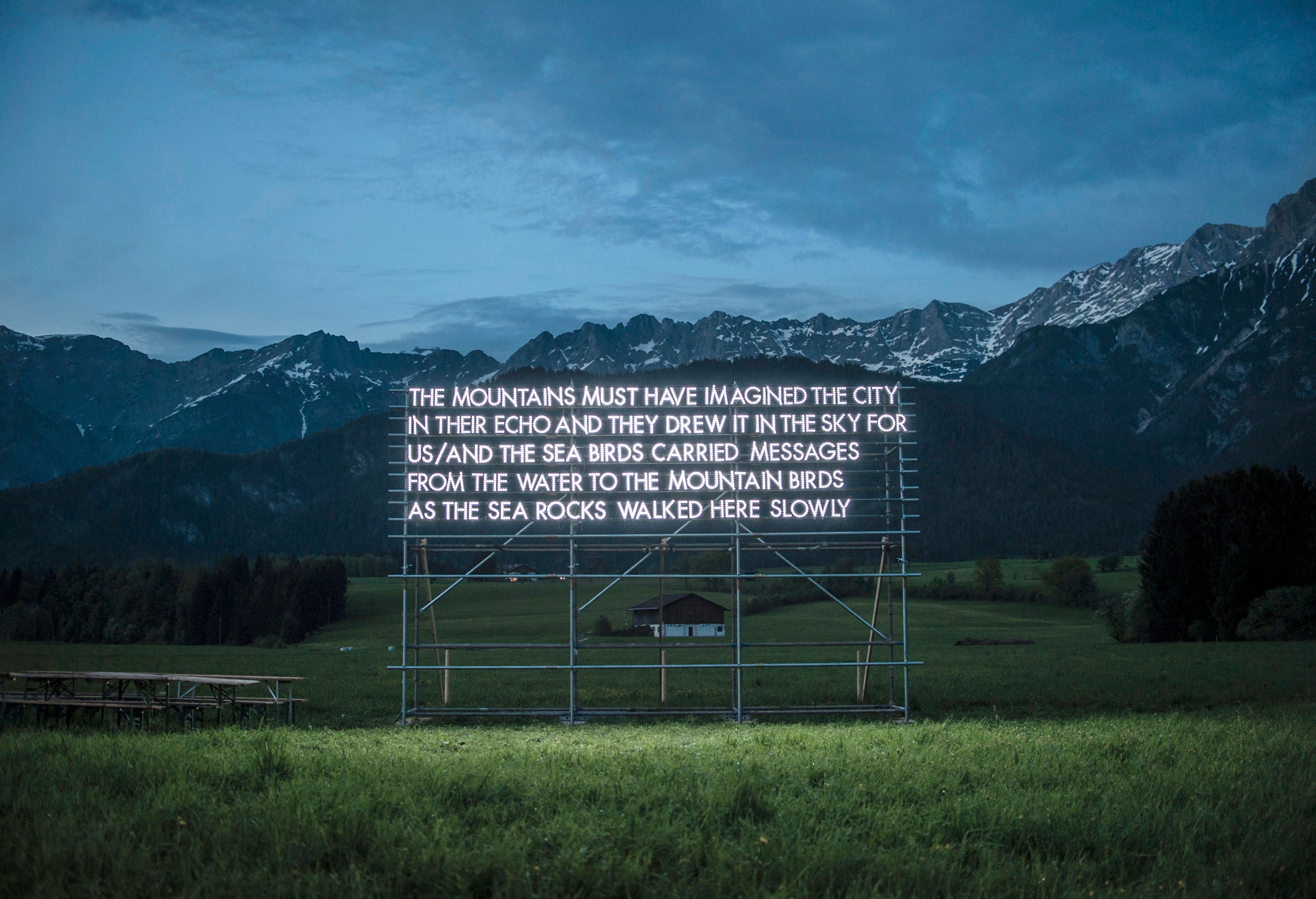
The Scottish contemporary artist Robert Montgomery has spent the last twenty years carving a unique niche in conceptual art, lighting up various global locales with abstract and often surreal ‘visual poems’ that seek to inspire a moment of inner reflection and activate the apparatus of wonder. His large-scale public commissions transform both urban and remote spaces with profound statements of hope that transmit a magical sense of the phenomenology of the moment – providing the viewer with a welcome antidote to the oversaturated bombardment of advertising media. These messages often straddle a strange paradox of melancholy and joy, deep diving into a Jungian notion of collective consciousness, while inviting radical individual contemplation of one’s place in the world. This January, his works take centre stage at the first ever light festival to take place in Mons, Belgium, where he is installing seven large-scale works that pay homage to the Belgian surrealist poets of the 20th century. Here, the outspoken artist discusses the genesis of the works to be unveiled in January, and tells us how he hopes to weave the ‘ghost of poetry’ into the architecture of the mediaeval city.
Do you recall what first turned you on to art as a child?
I can remember that I really wanted to paint light when I was a teenager. I loved watercolour painting and I always wanted to paint the luminosity of the sky, and I suppose that's still what I wanted to paint, really. In a way, all the light pieces I create on beaches or in a mountain landscape are contemporary reworkings of a 19th century landscape paintings – once I had begun making the lightworks I realised they were in some way contemporary re-workings of seascapes or sunset paintings in the tradition of Turner or Caspar David Friedrich. I'm always innately thinking of how to make that kind of image and activate that sensation or feeling where the luminosity of the sky carries you off into the heavens, or transmits a sense of eternity. There is a sense of the transcendence of nature in those paintings by Friedrich, or the god in nature. I think that's why I put so many of my light poem works in those kinds of landscapes and make them look the way they look.

There is an undefined spirituality in the work, where does that stem from – what would you say are your core spiritual beliefs?
Well, I believe in universal freedom and kindness, really. I don't believe in nation states. I don't actually believe in any of the things that separate us – including the identities that supposedly separate us. I know this might sound like a rather idealistic thing to say, but I believe that human beings have one shared soul. If you look at what all the major religions are trying to get at, I think they are basically trying to communicate the fact that the whole of humanity has a shared soul, and that when we sit together in peace that soul the human soul glows and grows and becomes an incredibly powerful entity. I think that's what they're talking about when they speak about God. I believe it’s far more likely that we have one human soul than it is that there's a separate God outside of us, and discovering a sense of that is what's important to me in my work. It’s about discovering the magic in the mundane, and the sacred that lives in the everyday because we tend to forget that to be living on this blue-skied planet as it spins through space and hurtles into a fragile future is intensely thrilling and frightening and even slightly supernatural.

Is the activation of that sense of phenomenological wonder key to why you create these works?
Yes. I think it is about trying to recover the sensation of realizing how magically frightening it is to be alive. I think the purpose of art and writing is really to keep you awake to the phenomenal and to try to remind us all that the magic of the universe is here in the now – and that we live in an innately magical world. That's my mission to myself in the work that I make, and I’ve tried really hard to put my work in public situations for those people who can’t take their kids to museums on a Saturday because they've got far more pressing things to do. It’s about presenting the work in a way that's non-hierarchical, in the sense that the viewer doesn't have to go to the museum or to know it's art. They can just read it and take it for what it is. I want my work to communicate with people who are standing at bus stops on the street or walking through the city at night.

Tell us about the work you are showing in Mons in January …
Xavier Roland the curator at the BAM museum in Mons has commissioned seven large works for the first light festival of the city of Mons in Belgium, which opens on the 25th January. The theme is a celebration of the 100 year anniversary of Surrealism. When Xavier wrote to me it was immediately my dream project, because the Surrealist Poets really influenced my work very strongly, and actually influenced the direction of my life. The first issue of La Révolution Surréaliste was published in Paris in 1924. In the 1990s, while I was studying painting at Edinburgh College of Art, I discovered the poetry of André Breton and Paul Éluard (reading them in the English translations by Samuel Beckett and Paul Auster). These poems were a fundamental influence on me. They were actually the thing that made me decide to use text in my work. Before I read the Surrealist poets, I was just a painter. After I read them I wanted to be both a painter and a poet, so really these poems changed the course of my work and my life. Something special happened when Beckett and Auster tried to make English do what Breton and Éluard were doing in French – they had to push at the boundaries of English to reach what the Surrealists were doing and they pushed the English language to do things it couldn't do yet. Underpinning the way I use language in my work, and the reason I use it in the first place, is still that strong influence of Breton and Éluard.

In a sense then you are paying tribute to the movement …
My works for Mons pay tribute to three of the Belgian Surrealist poets – Paul Nougé, Paul Colinet and Fernand Dumont. We have also, with my translator the Swiss poet Barbara Polla, made the first ever translations into English of poems by the notable female Belgian Surrealist poet Irène Hamoir (Irine). I have made five light works for Mons, and one metal work for Place Leopold, which will be permanent. They echo not just the voices of the Belgian Surrealist poets but the special typography and architecture of the city. For me Mons is a cosmopolitan city in miniature. Mons has been under the influence of many different countries in its history and you can see in its architecture, in the belfry and the cathedral, that it is a city that brings together the Gothic with the Classical and the Baroque. It is the missing gargoyles of the cathedral who give me the theme for the permanent work in Place Leopold. In my imagination the gargoyles didn't erode or fall, but they flew free, and now they fly above Mons as protectors of the city, writing invisible graffiti of love in the sky just above us. The cobblestones are the other very special aspect of Mons city architecture and my Place Leopold work references those cobblestones, under which you can find the traces and memory of almost all of our European history. I want my works to weave into the architecture of this very special place as almost a ghost voice, the ghost voice of poetry. I also hope the work in Mons has a little bit of humour.
Robert Montgomery exhibits in Mons, Belgium next month
You will be able to buy an exclusive print of the painting When We Are Gone The Trees Will Riot from the forthcoming House Collective Editions
Find out more about the artist here
Images (top to bottom): Portrait of the artist by Phillip Volkers; Love is the Revolutionary Energy, light poem, 2022; When We Are Gone The Trees Will Riot, acrylic on canvas. 2019; Robert Montgomery and Greta Bellamacina. Bombay Beach Fire Poem, 2018; Searock Songlines. Light poem Saafelden Leogang, Austria. 2018.